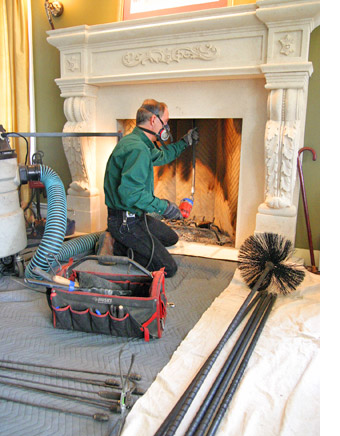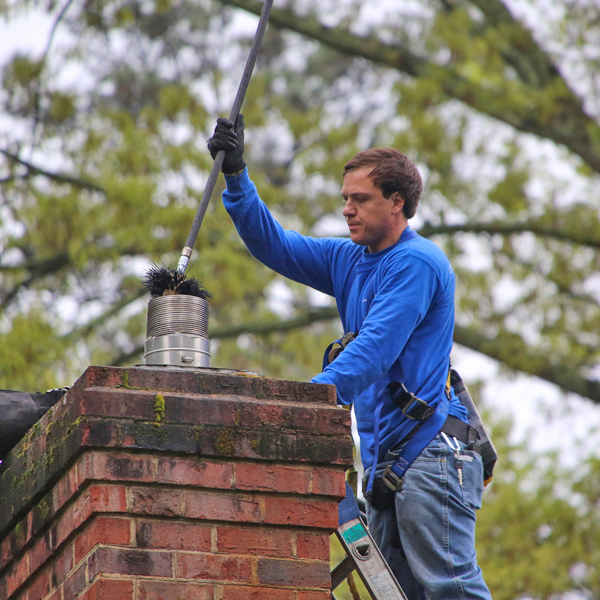Chimney Clean San Jose Quality: Guaranteeing a Tidy and Reliable Fireplace
Chimney Clean San Jose Quality: Guaranteeing a Tidy and Reliable Fireplace
Blog Article
Chimney Cleansing: A Step-by-Step Guide to Preserving a Healthy And Balanced Fire Place
Maintaining a healthy and balanced fireplace is important for the safety and security and performance of your home. Regular chimney cleaning is an important part of this maintenance routine. In this step-by-step overview, we will supply you with thorough instructions on how to correctly clean your chimney, making sure that it works ideally and reduces the risk of fire hazards. By following these guidelines, you will learn how to gather the necessary devices, execute an aesthetic inspection, clear debris and accumulation, move the smokeshaft, and complete the last steps for recurring upkeep. With a specialist method and focus to information, you can with confidence take care of your fire place and appreciate its warmth and convenience for years to come.
Collecting the Required Tools
To begin the procedure of chimney cleansing, the very first step is to collect all the necessary devices. Having the right devices at hand ensures a reliable and risk-free cleaning procedure. The important devices for chimney cleaning consist of a chimney brush, a ladder, decline fabrics or plastic sheets, a flashlight, gloves, and a dust mask.
The chimney brush is the key tool made use of to remove residue and creosote build-up from the flue - Chimney Clean San Jose. It is essential to choose a brush that matches the size and form of your chimney.
Decrease towels or plastic sheets are essential for shielding the surrounding location from dirt and debris. They assist make and include the mess cleaning simpler. A flashlight is crucial for inspecting the chimney's interior for any kind of signs of damage or blockages. Handwear covers are necessary to safeguard your hands from residue and other damaging compounds, while a dust mask assists avoid the breathing of debris.
Carrying Out an Aesthetic Assessment

Utilizing a flashlight, meticulously examine the indoor wall surfaces of the chimney for any indications of damages, such as fractures, loosened blocks, or mortar wear and tear. These problems can endanger the smokeshaft's architectural honesty and pose a severe safety and security hazard. Additionally, check for any signs of water damage, such as staining or efflorescence, as this can suggest a leaking chimney cap or flashing.
Next, examine the chimney flue for any type of blockages. Try to find the existence of nesting materials, leaves, or debris that may have collected gradually (Chimney Clean San Jose). These blockages can restrict airflow, increase the risk of carbon monoxide gas buildup, and hinder the smokeshaft's capacity to properly air vent smoke
During the visual inspection, pay close attention to the chimney crown, which is the leading surface area that secures the chimney from wetness. Try to find fractures or missing items in the crown, as these can enable water to enter the smokeshaft and create substantial damages.
Clearing Particles and Accumulation
After completing the visual inspection, the following action in chimney cleansing includes clearing particles and accumulation to guarantee the correct functioning of the fireplace. With time, particles such as leaves, twigs, and pet nests can gather in the smokeshaft, obstructing the circulation of air and causing prospective fire dangers. Furthermore, the build-up of creosote, a tar-like compound, is a common issue in smokeshafts. Creosote is created when wood or fossil fuels are melted, and if not eliminated on a regular basis, it can result in smokeshaft fires.
To remove debris and accumulation, it is very important to utilize the right tools and methods. A chimney brush, particularly created for this function, is used to eliminate loose particles and creosote from the chimney walls. It is necessary to select a brush that matches the dimension of your smokeshaft to make sure efficient cleaning. Before starting the cleaning procedure, ensure to cover the fireplace available to avoid debris from coming under the space.
To begin, put the brush into the smokeshaft and move it up and down, rubbing the wall surfaces to dislodge any particles or creosote. When the brushing is complete, use a vacuum cleanser or a chimney brush expansion to remove the dislodged particles from the fire place.

Brushing Up the Chimney
The sweeping of the chimney is a crucial action in keeping a healthy fire place. Gradually, residue, creosote, and other debris can collect in the smokeshaft, blocking the flow of air and potentially triggering a harmful build-up internet of combustible materials. Normal chimney sweeper not just guarantees proper air flow however additionally protects against the threat of smokeshaft fires.
When it comes to chimney sweeping, it is very recommended to hire a specialist chimney move. These experts have the expertise and tools essential to safely and effectively eliminate the accumulated particles from your chimney.
It is necessary to note that the regularity of chimney sweeping depends upon numerous elements, such as the sort of fuel made use of, the quantity of usage, and the kind of smokeshaft. As a basic guideline, it is suggested to have your smokeshaft inspected and swept at least annually.
Final Steps and Upkeep
To ensure continuous upkeep and optimal performance, it is crucial to apply routine upkeep techniques and comply with a comprehensive set of last actions for your fire place. After completing the chimney sweeping process, the primary step in the last upkeep is to evaluate the chimney cap and spark arrestor. These elements protect against debris, animals, and rainwater from going into the smokeshaft. Look for any kind of signs of damages or clog, and tidy or fix them if necessary.

Evaluate the inside of the fireplace for any type of indications of damage, such as cracks, loose bricks, or damaged mortar. These problems can impact the structural stability and safety and security of the fireplace. If any kind of problems are identified, get in touch with a professional chimney sweep or mason to resolve them web immediately.
Lastly, think about setting up carbon monoxide detectors near the fireplace and throughout your home. These devices can detect the presence of this harmful gas, offering an early caution system in instance of a smokeshaft breakdown. On a regular basis inspect and replace the batteries in these detectors to guarantee their performance.
Conclusion
In verdict, complying with a step-by-step overview for smokeshaft cleaning is important in maintaining a healthy and balanced fire place. By gathering the necessary devices, carrying out a visual examination, getting rid of debris and accumulation, and brushing up the chimney, home owners can make sure the safety and security and efficiency of their fireplace.
The vital tools for smokeshaft cleansing consist of a chimney brush, a ladder, drop towels or plastic sheets, a flashlight, gloves, and a dust mask.
A smokeshaft brush, particularly created for this purpose, is made use of to eliminate loose particles and creosote from the chimney wall surfaces. Routine smokeshaft sweeping not just guarantees appropriate ventilation however also stops the risk of chimney fires.
When it comes to smokeshaft sweeping, it is highly recommended to work with a professional smokeshaft move. After completing the smokeshaft sweeping process, the very first step more in the last maintenance is to examine the smokeshaft cap and spark arrestor.
Report this page